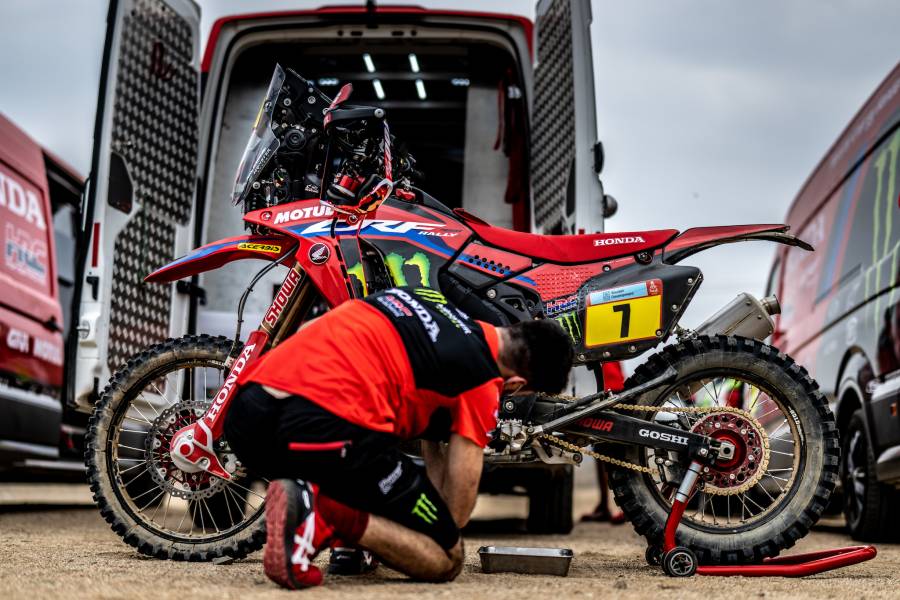【Dakar 2023 Special④】 Regulations Make the Dakar Rally Special

Dakar Rally regulations change every year, making the event more interesting for spectators not only because it makes the riders’ jobs more difficult, but the changes also reveal the organizer's intentions to solve issues that become more apparent with each rally. Read on to learn about regulation changes over the 2020 to 2023 period, when the event moved to Saudi Arabia, focusing on four categories: navigation, safety, bike maintenance, and strange.
① Navigation
2020→2021
Timing of roadbook distribution
Since 2021, roadbooks were distributed to riders just before the start of each stage. This method, applied to limited stages in 2020, was now the default. When roadbooks were distributed beforehand, riders and map men, specialists at analyzing routes, would figure out the best route for the rider to take. This became impossible once roadbokks were handed our just before a stage started. This move increased fairness for all riders, and tested the riders' abilities to respond to the added challenge.
Slow Zones introduced
Along the route, some zones are more hazardous than others, designated as level 2 and 3 zones. To reduce accidents in these zones, audible tones alert approaching riders. Severly hazardous areas are designated as slow zones, where the speed limit is set to 90 km/h. These regulation changes made rider mentality, riding fast but safe, more important.
2021→2022
Failing to finish a stage does is not the end
In the past, the race ended for riders / drivers / crews who failed to finish a stage. Starting in 2022, they are able to continue racing even if they could not complete the prior stage. They must, however, rejoin at least three days before the final stage, they cannot retire more than two times, and they must be medically certified.
Waypoints added
Waypoints were added to check the riders’ accuracy in following the roadbook route. The organizer determines whether riders pass required points according to the bikes’ GPS signals. As riders cannot see their own GPS data, they have to rely on the numbers in the roadbook and the route. Failure to pass a waypoint results in a 2-minute penalty.
2022→2023
Fully-digital roadbook
Road books, which were previously distributed on paper, were replaced by digital roadbooks for all categories, distributed on tablets. Tests were conducted for car and truck categories, before being rolled out for all categories in the 2023 Dakar.
Introducing bonus time
As a new rule, riders who reach a waypoint (located around 200 km from the starting point) early receive bonus time the following day. The first three riders are awarded bonus time. For example, for a waypoint located at 200 km from the start, fastest rider is awarded 200 x 1.5 seconds = 5 minutes, the second rider 200 x 1 second = 3 minutes 20 seconds, and the third 200 x 0.5 seconds = 1 minute 40 seconds. Riders with better navigation skills will have a greater advantage.
A and B, two routes distributed at random
New for 2023, the routes of most of the special stages will be split into two, with the roadbooks of A and B routes assigned randomly to riders. The aim is to increase the difficulty of the route. For riders, it will be more difficult to follow the rider in front, as they will not know if they are on the same route. The rider’s adaptability will be tested more than ever.

② Safety for long distance racing
2020→2021
No repair work while refueling
Repair work by mechanics at refueling points and neutral zones (sections of the special stage where time is not measured) became prohibited. As the organizer intended the 15-minute break to allow for refueling and resting, riders were encouraged to take that break as intended. In addition, riders were required to ride more carefully because mechanics were no longer allowed to support them.
Mandatory airbag vests
Airbag vests became mandatory in the motorcycle and ATV categories. These vests were proven to reduce injuries in MotoGP, and were introduced to the Dakar to enhance safety in the event of a crash.
2021→2022
Ultra-light helmets banned
The minimum weight of helmets was set at 1.1 kg, and lighter helmets were prohibited. This decision was made in consideration of durability.

③Bike maintenance
2020→2021
Number of rear tires
Up to six rear tires can be used during the event. All tires must be of the same brand and the same model for all stages. This change is in line with the recent evolution of bikes which had become so fast, that it had started to resemble a motocross race, a competition for speed. The change was made to improve safety and to bring the focus back to the endurance and stamina that the Dakar Rally demands.
Time penalty for second piston replacements
Originally, there was a time penalty for any maintenance on the engines. In addition, if pistons are replaced twice, there is a time penalty even if other components including the engine are not maintained. This is another rule change that takes into account the evolution of motorcycles.
2021→2022
Engine may be opened once for piston replacement
From 2022, the top of the engine may be opened without penalty when replacing a piston, as long as only the piston ring and piston pin are replaced, and under the supervision of a race marshall. This may only happen once. Adherence to the regulations are strictly controlled.

④The strange
2022→2023
Amateur riders are now eligible for daily prize money. This rule was added to honor amateur riders who participate in the Dakar Rally, in the hope that the prize money would raise riders' spirits toward finishing the race.
Index
1.Monster Energy Honda Team 2022 in action
2.The Five Phases of Dakar Rally History
3.The Dakar Rally You Didn’t Know
4.Regulations Make the Dakar Rally Special